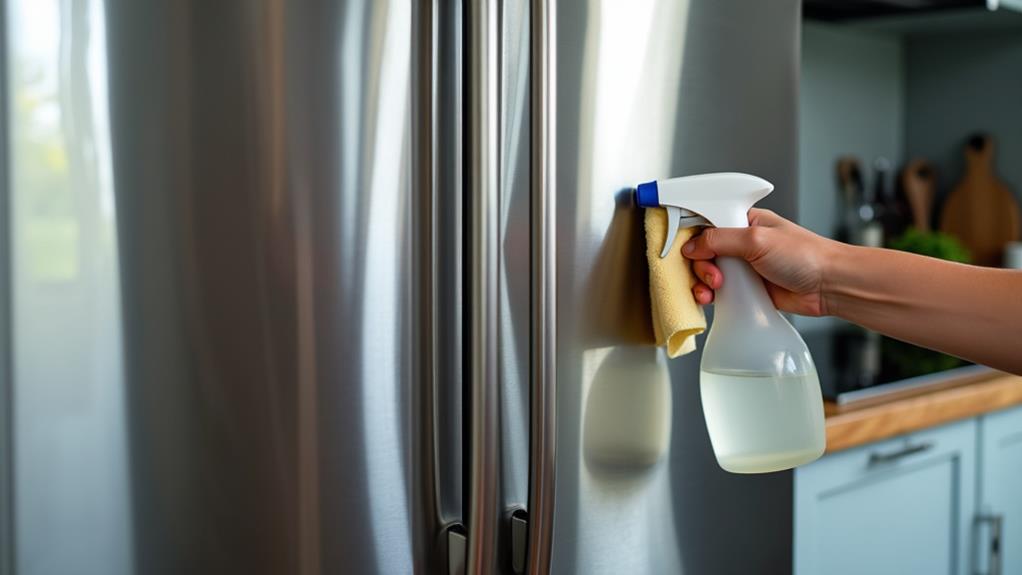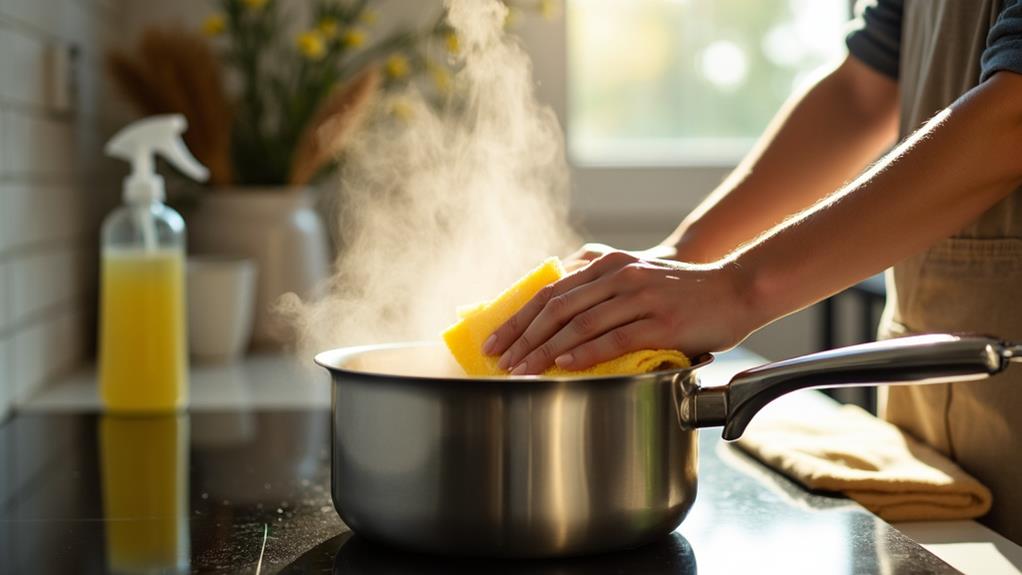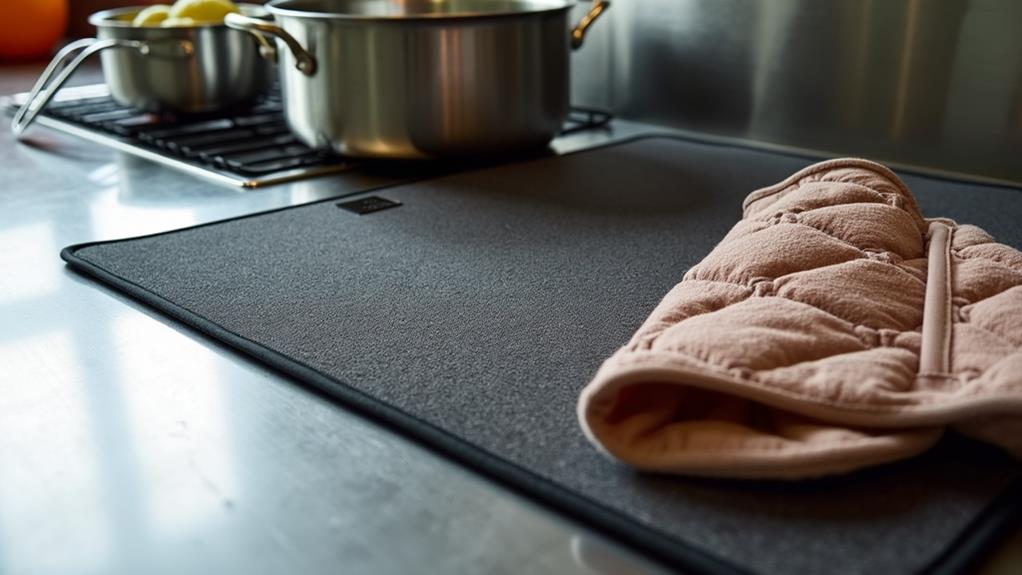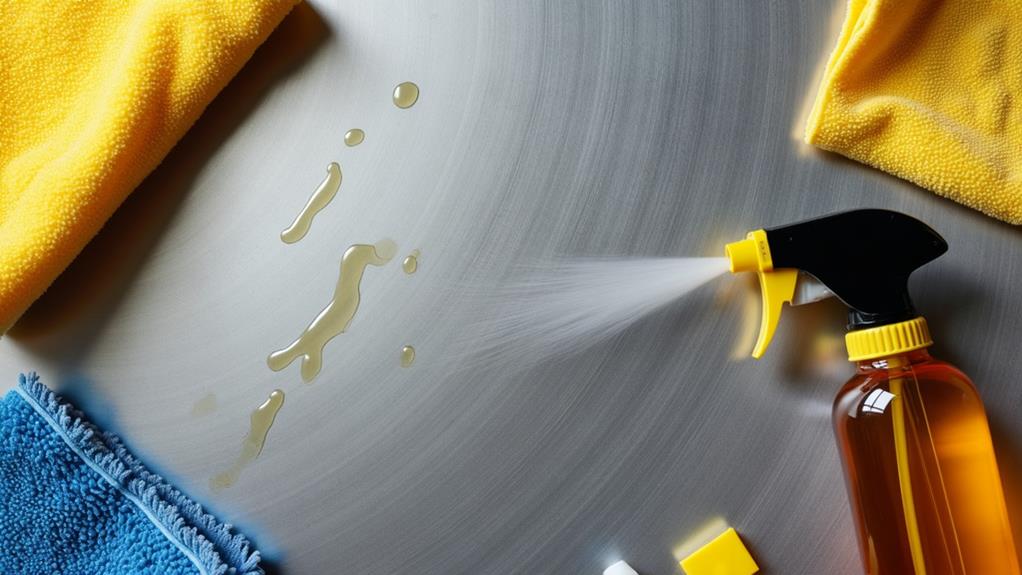How to Prevent Rust on Stainless Steel in Humid Areas

To prevent rust on stainless steel in humid areas, choose the right grade, like 316 stainless steel, for better corrosion resistance. Clean surfaces regularly with mild soap and water, then dry thoroughly. Apply protective coatings, such as clear or oil-based ones, to create a barrier against moisture. Keep humidity levels in check with dehumidifiers and guarantee proper ventilation. Store stainless steel in dry, well-ventilated spaces and inspect regularly for early signs of rust. Follow these steps to keep your stainless steel rust-free, and you'll uncover more effective methods to protect your items.
Understanding Stainless Steel Grades
Stainless steel comes in different grades, each with unique properties tailored for specific applications. When you're looking to prevent rust, it's essential to understand these grades and their stainless steel properties. The most common types are 304 and 316 stainless steel.
304 stainless steel is widely used due to its excellent corrosion resistance and affordability. It's perfect for general-purpose applications, but if you're dealing with highly corrosive environments, you might need something stronger. That's where 316 stainless steel comes in. It has a higher nickel content and includes molybdenum, which considerably improves its corrosion resistance, especially against chlorides and marine environments.
Choosing the right grade for your needs can make all the difference. If you're in a humid area, opting for 316 might save you a lot of headaches down the road. Remember, the better the grade, the better it will resist rust and last longer without requiring constant maintenance. Always consider the specific conditions your stainless steel will face and choose a grade that offers the best protection and longevity. This way, you'll guarantee your investment stands the test of time.
Proper Cleaning Techniques
Keeping your stainless steel free from rust starts with proper cleaning techniques. Initially, choose the right cleaning materials. Use a soft cloth or sponge along with mild soap and warm water. Avoid abrasive cleaners and steel wool, as they can scratch the surface and make it more susceptible to rust. For tougher stains, a mixture of baking soda and water can work wonders without damaging the metal.
Next, consider your cleaning frequency. In humid areas, it's vital to clean your stainless steel more often to remove any contaminants that could lead to rust. Aim for at least once a week, but if your environment is particularly damp, you might need to increase this to every few days. Regular cleaning prevents the buildup of dirt, salt, and other corrosive substances.
Always dry your stainless steel thoroughly after cleaning. Moisture is a primary culprit in rust formation, so using a dry cloth to wipe down the surface can make a significant difference. By using these proper cleaning techniques, you'll extend the life and appearance of your stainless steel items, keeping them rust-free even in humid conditions.
Regular Maintenance Schedule
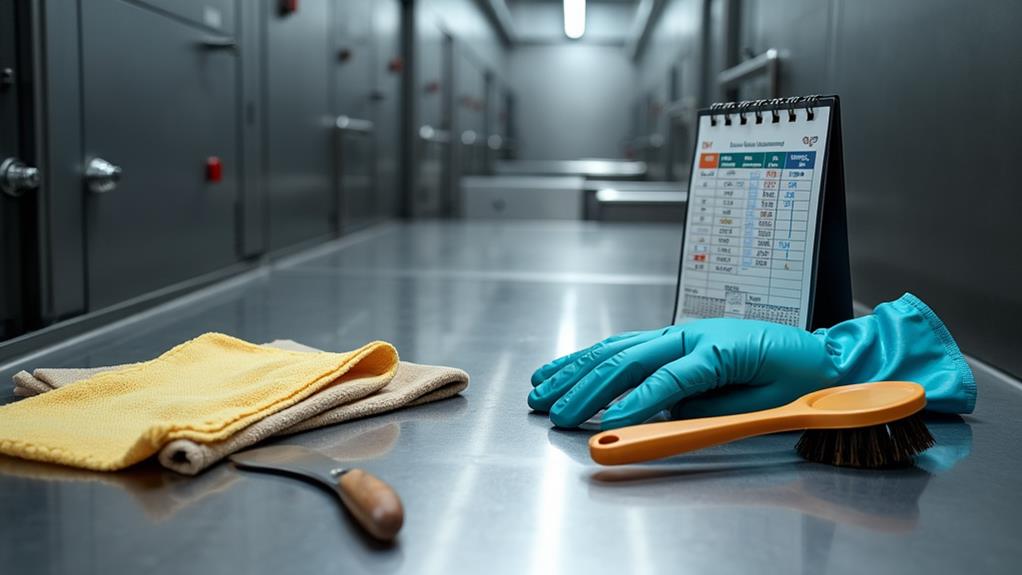
After mastering proper cleaning techniques, establishing a regular maintenance schedule is the next step to prevent rust on your stainless steel items. This schedule acts as one of the most effective preventive measures in humid areas. By adhering to a consistent maintenance frequency, you guarantee that your stainless steel remains in top condition.
Start by inspecting your stainless steel items weekly. Look for any signs of discoloration or minor rust spots. Catching these early can save you a lot of hassle later. Depending on your environment's humidity levels, you might need to adjust your maintenance frequency. In particularly humid areas, a bi-weekly inspection might be more appropriate.
During each inspection, make certain to wipe down your items with a dry, clean cloth. This simple act helps remove moisture and prevent rust from forming. Moreover, use a mild detergent and water mixture to clean the surfaces, followed by a thorough drying. Avoid using abrasive materials that could scratch the steel and make it more susceptible to rust.
Using Protective Coatings
One effective way to shield your stainless steel items from rust is by applying protective coatings. These coatings act as a barrier between the metal and the humid air, preventing moisture from initiating the rusting process. You'll find a range of coating types available, each offering different levels of protection.
For instance, clear coatings are popular because they don't alter the appearance of your stainless steel. They form a transparent layer that prevents rust while keeping the metal's natural look. Another option is using oil-based coatings, which provide excellent protective applications by repelling water and sealing the surface. These are particularly useful for items exposed to extreme weather conditions.
Additionally, wax coatings can offer a good balance between protection and maintaining a clean look. They're easy to apply and can be buffed to a shine, making them ideal for smaller stainless steel items.
Whatever coating type you choose, be certain to follow the manufacturer's instructions carefully for the best results. Regularly inspect and reapply the coating as needed to guarantee ongoing protection. By investing a little time and effort into applying protective coatings, you can greatly prolong the lifespan of your stainless steel items in humid areas.
Controlling Humidity Levels
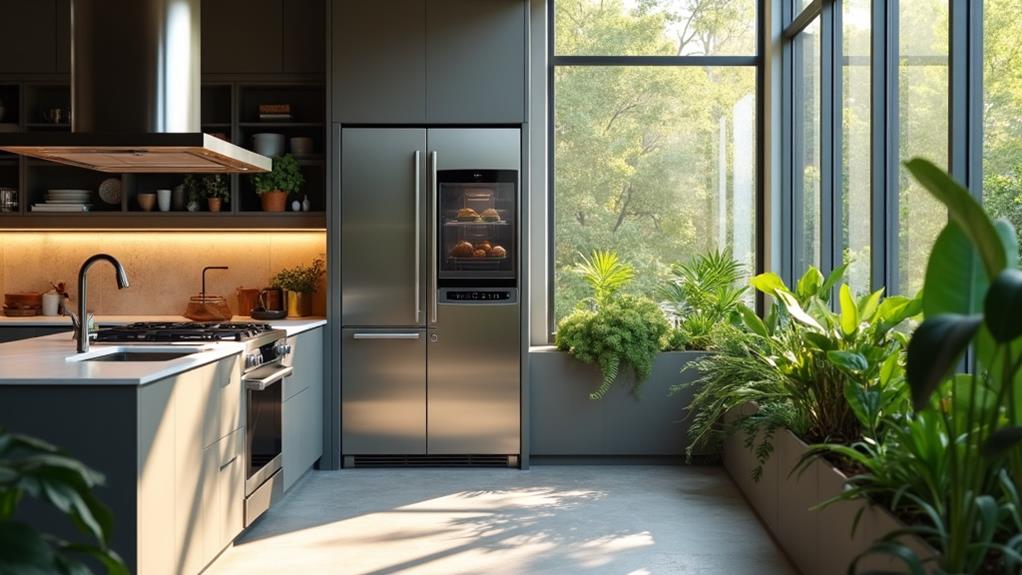
Maintaining the right humidity levels is vital for preventing rust on stainless steel. To achieve effective humidity control, start by regularly monitoring the humidity in the area where your stainless steel items are stored. Invest in a reliable hygrometer to keep track of moisture levels. Ideally, you want to maintain indoor humidity between 30-50%. High humidity accelerates rust formation, so keeping it in check is critical.
Use dehumidifiers to reduce excess moisture in the air, especially in areas prone to high humidity. For smaller spaces, silica gel packets or moisture absorbers can be effective. Guarantee good ventilation, as stagnant air can trap moisture and increase the likelihood of rust. Fans, exhaust systems, and open windows can help circulate air and reduce humidity levels.
Don't forget to address any sources of moisture, such as leaks or spills, promptly. Regularly inspect and repair any plumbing issues to keep the area dry. If you store your stainless steel items in a basement or garage, consider using a vapor barrier to prevent ground moisture from seeping in. Effective moisture management is critical for protecting your stainless steel investments from rust in humid environments.
Applying Rust Inhibitors
In conjunction with controlling humidity levels, applying rust inhibitors is another effective strategy to prevent rust on stainless steel. By taking this supplementary step, you can extend the life of your stainless steel items, especially in humid areas where rust tends to form more easily.
Here are some rust prevention techniques involving rust inhibitors:
- Choose the Right Sealant: Not all sealants are created equal. Look for rust inhibitors specifically designed for stainless steel. These sealants create a protective barrier that prevents moisture from reaching the metal surface.
- Apply Evenly and Liberally: When applying sealants, make certain you cover the entire surface evenly. Missing spots can leave areas vulnerable to rust. Use a brush or sprayer for thorough coverage.
- Regular Maintenance: Reapply the sealant periodically. Over time, the protective layer can wear off, especially in harsh conditions. Check the manufacturer's recommendations for reapplication intervals.
- Clean Before Application: Before applying any rust inhibitors, verify the stainless steel is clean and dry. Dirt and moisture can reduce the effectiveness of the sealant.
Choosing the Right Environment
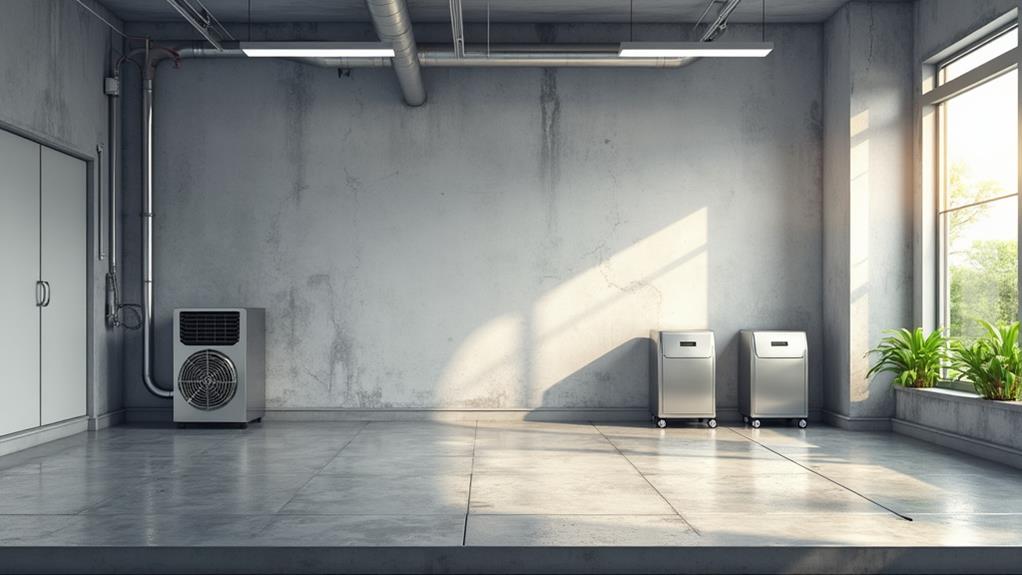
Choosing an ideal environment is fundamental to maintaining the integrity of your stainless steel items. You need to take into account diverse environmental factors that can contribute to rust formation, especially in humid areas. Humidity, temperature fluctuations, and exposure to salts or chemicals are key factors to monitor. By understanding these elements, you can make informed decisions to protect your stainless steel.
When selecting the right environment, think about where you'll be placing your stainless steel items. Avoid areas with high humidity levels, like basements or unventilated spaces. If you can't avoid these conditions, contemplate enhancing ventilation or using dehumidifiers to control moisture levels. This proactive approach can greatly reduce the risk of rust.
Material selection also plays a vital role. Opt for higher-grade stainless steel, such as 316, which offers better resistance to corrosion in humid and marine environments. Lower-grade options may be more susceptible to rust, so investing in quality materials upfront can save you trouble in the long run.
Proper Storage Solutions
To effectively prevent rust on stainless steel, you must implement proper storage solutions. Start by considering the environment and how it impacts your stainless steel items. Here are some key strategies:
- Choose Proper Storage Materials: Avoid storing stainless steel directly on the ground or on surfaces that trap moisture. Use racks, pallets, or shelves made from non-corrosive materials like plastic or treated wood.
- Ventilation Strategies: Make certain your storage area has adequate airflow. Poor ventilation can trap moisture, increasing the risk of rust. Use fans, dehumidifiers, or air conditioning to keep the relative humidity low and air circulating.
- Keep It Covered: Cover your stainless steel items with breathable materials like canvas or specialized rust-preventive covers. Avoid using plastic sheets, which can trap moisture and accelerate rust formation.
- Separate Different Metals: Store stainless steel separately from other metals like iron or carbon steel. Contact between different metals can cause galvanic corrosion, leading to rust on your stainless steel items.
Inspecting for Early Signs
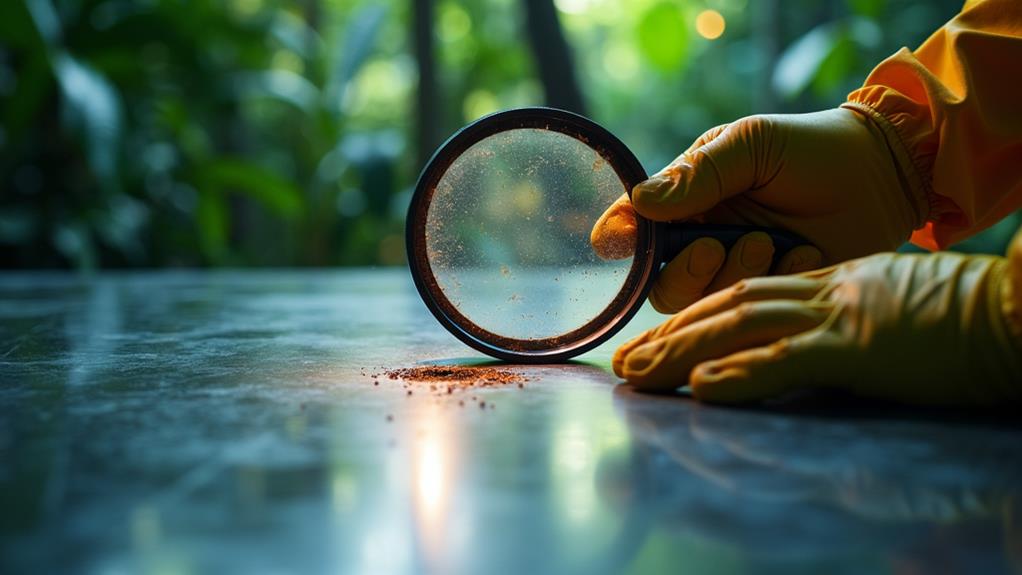
How can you guarantee your stainless steel remains free of rust? Regular inspections are key. Start by examining your stainless steel items for visual rust indicators. Look out for small reddish-brown spots or streaks, especially in corners and crevices where moisture might accumulate. Early detection of these signs can prevent minor rust from becoming a significant problem.
Next, focus on moisture detection. Humid areas can trap water on the surface of stainless steel, accelerating rust formation. Use a dry cloth to wipe down the metal and check for any dampness. If moisture is present, identify the source and take steps to eliminate it. This could involve improving ventilation or using dehumidifiers in the storage area.
Don't forget to inspect less obvious areas. Rust can often start in hidden spots, such as underneath fittings or on the backside of panels. A small mirror or a flashlight can help you see these hard-to-reach places. By being vigilant and proactive in your inspections, you'll catch rust early and maintain the integrity of your stainless steel in humid environments. Regular checks can save you time and money in the long run.

